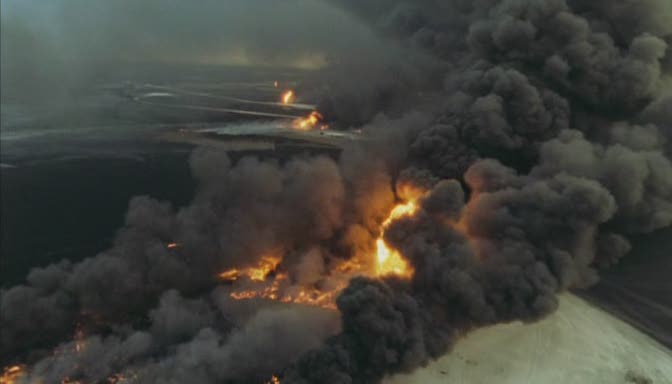Da ich kürzlich die atemberaubende Dokumentation „Lektionen in Finsternis“ (Lessons Of Darkness) von Werner Herzog gesehen habe, bin ich über Herzogs Manifest zum Prinzip „Wahrheit im Film“ gestoßen. Für „Lektionen in Finsternis“ begibt sich Herzog 1992 in das vom ersten Golfkrieg zerstörte Kuwait und es wäre falsch, diesen Film eine Dokumentation zu nennen, nur weil er sich der Mittel des Dokumentarfilms bedient. Vielmehr sind Herzogs Lektionen in Finsternis ein Essay über das Unaussprechliche, die Zerstörung der Welt und eine, man kann es nicht anders sagen, bizarre Schönheit in all dem.
Herzog findet Bilder, die man so noch nie im Kino gesehen hat und die jedem Regisseur, der einen postapokalyptischen Film plant, als Messlatte vorgesetzt werden müssten. Und in diesen Bildern liegt eine Wahrheit, die über die dokumentarische Schilderung eines Zustands hinausgeht. Es ist die „ecstatic truth“, die Herzog anstrebt und die sich von einer „Wahrheit der Buchhalter“* abhebt, die nur aufzeichnen, was geschieht.
[vimeo]http://vimeo.com/14958024[/vimeo]
Wie immer verliert Herzog aber weder beim Filmen des Unerträglichen noch beim Formulieren eines Manifests seinen Humor. Bei Herzog kann ein Manifest mit dem Satz „Life in the oceans must be sheer hell. A vast, merciless hell of permanent and immediate danger. So much of a hell that during evolution some species – including man – crawled, fled onto some small continents of solid land, where the Lessons of Darkness continue.“ enden und trotzdem im Mittelteil eine Schmähkritik gegen die von ihm nicht für voll genommenen Vertreter des Cinema Verité beinhalten: „Filmmakers of Cinema Verité resemble tourists who take pictures amid ancient ruins of facts. Tourism is sin, and travel on foot virtue.“.
Herzog in a nutshell:
„LESSONS OF DARKNESS“
Minnesota declaration: truth and fact in documentary cinema
1. By dint of declaration the so-called Cinema Verité is devoid of verité. It reaches a merely superficial truth, the truth of accountants.
2. One well-known representative of Cinema Verité declared publicly that truth can be easily found by taking a camera and trying to be honest. He resembles the night watchman at the Supreme Court who resents the amount of written law and legal procedures. „For me,“ he says, „there should be only one single law: the bad guys should go to jail.“
Unfortunately, he is part right, for most of the many, much of the time.
3. Cinema Verité confounds fact and truth, and thus plows only stones. And yet, facts sometimes have a strange and bizarre power that makes their inherent truth seem unbelievable.
4. Fact creates norms, and truth illumination.
5. There are deeper strata of truth in cinema, and there is such a thing as poetic, ecstatic truth. It is mysterious and elusive, and can be reached only through fabrication and imagination and stylization.
6. Filmmakers of Cinema Verité resemble tourists who take pictures amid ancient ruins of facts.
7. Tourism is sin, and travel on foot virtue.
8. Each year at springtime scores of people on snowmobiles crash through the melting ice on the lakes of Minnesota and drown. Pressure is mounting on the new governor to pass a protective law. He, the former wrestler and bodyguard, has the only sage answer to this: „You can´t legislate stupidity.“
9. The gauntlet is hereby thrown down.
10. The moon is dull. Mother Nature doesn’t call, doesn’t speak to you, although a glacier eventually farts. And don´t you listen to the Song of Life.
11. We ought to be grateful that the Universe out there knows no smile.
12. Life in the oceans must be sheer hell. A vast, merciless hell of permanent and immediate danger. So much of a hell that during evolution some species – including man – crawled, fled onto some small continents of solid land, where the Lessons of Darkness continue.
Walker Art Center, Minneapolis, Minnesota April 30, 1999 Werner Herzog




[…] Werner Herzog – “LESSONS OF DARKNESS” […]